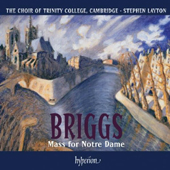
DEFINITIVE RECORDINGS

All of you who have become convinced that any new music being written these days is only going to be either boring formulaic minimalism, atonal noise, eletronic
manipulation, or worst of all, tepid crossover attempts to draw a different crowd, can all breathe a deep sigh of relief. David Briggs (b1962) has come to the
rescue with this jaw-dropping Mass for Notre-Dame, composed in 2002.
David Briggs is one of today's best organists and one of the leading organ improvisers, following along the line of greats such as Dupré, Cochereau, Guillou, Latry ...and
his writing is very much old school and on a grand scale, somewhat like Langlais and Duruflé, but even better in my opinion. The various organ improvisations in particular, that act
as instrumental interludes within the framework of the Mass, are quite simply wonderful. They bring to mind the glory days of the mighty pipe organ. One fine example is
the Toccata on Te Deum Laudamus in which while both hands are fiendishly working away at top speed on a remote subject, the mighty pedals are
slowly and loudly proclaiming the melody proper of the Te Deum, and it all culminates on one of those glorious full-bore, plein jeux, all stops open chord
underpinned by a 32' Bombarde pedal stop that makes all the hairs on the back of your neck rise to attention. The choral writing is just as stunning in its rich harmonic
colors, adventurous intervals, long flowing lines and cathedral filling 'grandeur'. This is bold music in the best sense of the word, and it also, thankfully, defies the idea
that all music these days needs to be homogenous and discrete in order to be effective.
The stunning Hyperion recording was done in Gloucester Cathedral, and it sounds as though the microphones were positioned in such a way as to fully
capture the building's acoustics and long reverberation, and therefore allow those massive organ chords to roll down along the ceiling. The 30-voice Trinity
College Choir on the other hand, would have benefited from a closer microphone set-up for a stronger impact, but then I assume that by doing that, the feeling
of being in a grand open space would have been lost.
So if you would like to feel the cathedral of today's music tremble down to its foundation, get your hands on this stunning mass. A piece of music composed for a monumental
building on a monumental scale, with not a sign of minimalism to be seen as far as the eye can see.
Below is a clip of the Gloria from the mass, but this time with a different choir.
Jean-Yves Duperron